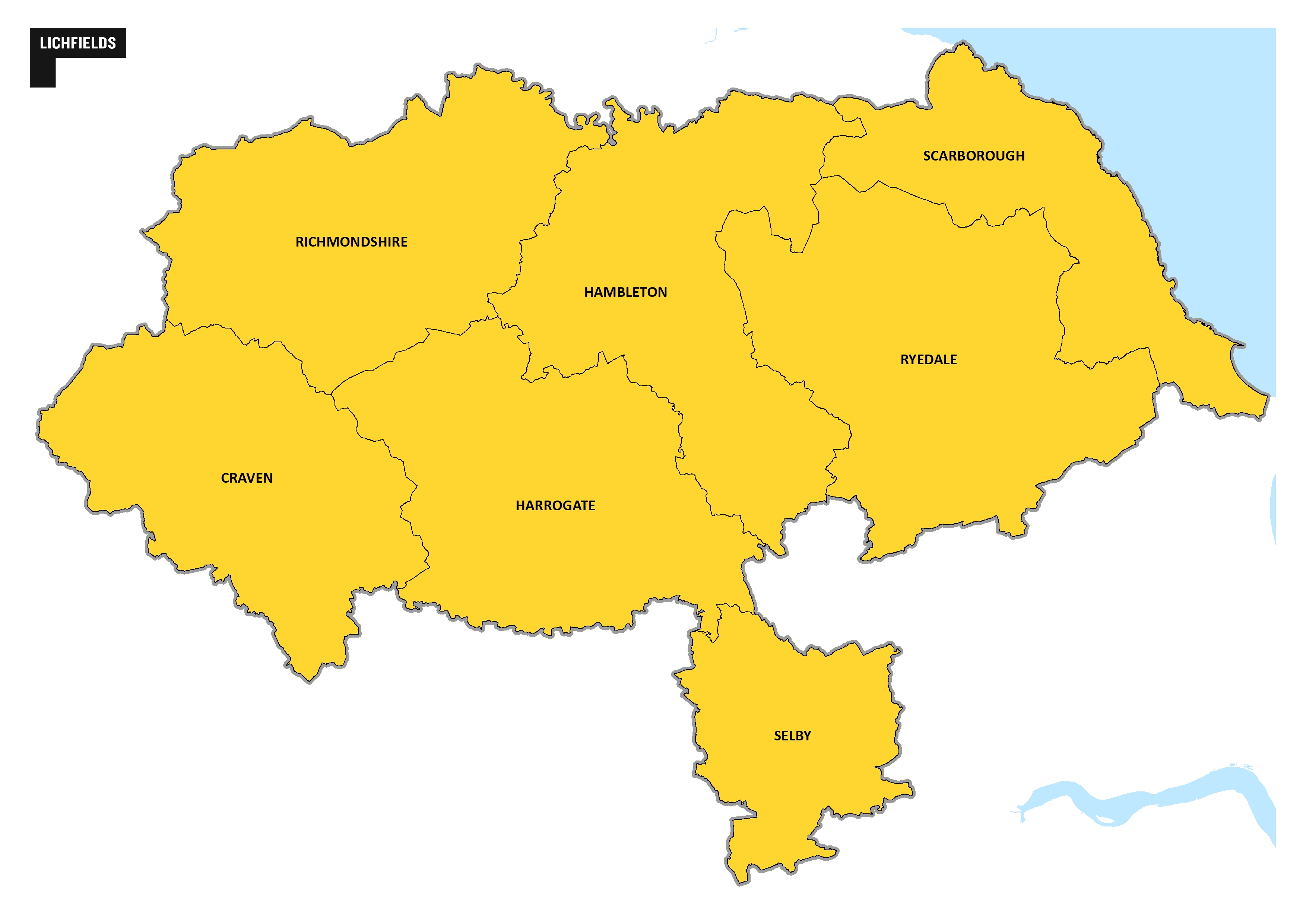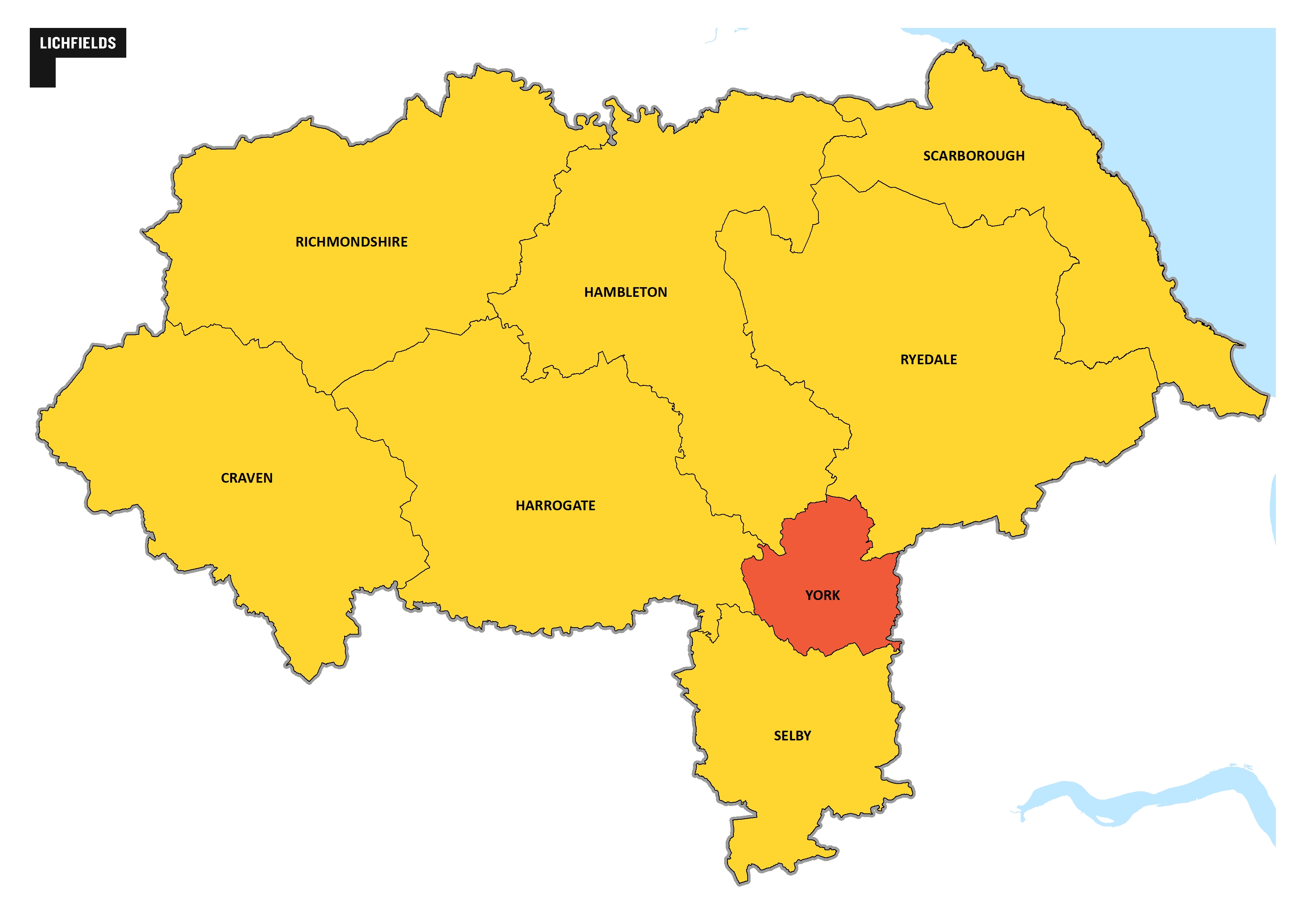The North Yorkshire Combined Authority will come into being in less than 10 weeks, yet there appears to be a surprising lack of information as to how the new Council will operate.
This blog seeks to pull together what information is currently known about the new authority, how it will operate and what this all means for planning in North Yorkshire.
The Structure
A new single council for North Yorkshire will replace a number of existing county, district and borough councils (excluding York City Council) in North Yorkshire from April 2023. The existing councils, which will become part of the North Yorkshire Combined Authority, are shown in the map below and, extending to around 8000 square kilometres, will result in the largest Local Planning Authority (LPA) by area in England.
Figure 1: Map of District Councils to be replaced by the North Yorkshire Combined Authority
Source: Lichfields
County elections took place in May 2022, and these councillors will continue to serve the new authority from April 2023. As such, there will no longer be district councillors. This has direct implications for planning as some of these councillors will sit on the newly formed planning committees.
What does this mean for planning services in general?
Currently district councils provide the bulk of planning services, with North Yorkshire County Council determining mineral and waste planning applications.
Following the formation of the North Yorkshire Combined Authority, planning services (amongst other services) will be provided from one centralised body.
It is expected that existing council offices will provide office space for staff and meeting facilities in each of the existing district areas.
What does this mean for plan making?
The new North Yorkshire Combined Authority will consolidate numerous LPAs that are at different stages of plan making.
A report to the Executive Committee at North Yorkshire County Council recommended that a single local plan be prepared and progressed as far as possible within five years – as required by The Local Government (Structural Changes) (Transitional Arrangements) (No.2) Regulations 2008 (as amended).
They are aiming for work on the new local plan to start as soon as possible. A separate Minerals and Waste Local Plan is also proposed to be prepared.
This will mean that the Craven, Hambleton, Harrogate District, Richmondshire and Scarborough Borough Local Plan Reviews will eventually be halted in order to focus resources on preparing a new Local Plan, which are currently at different stages of review.
Some current consultations, such as the Draft Scarborough Local Plan Review, will continue but will not progress beyond this stage.
However the following reviews, that are at a more advanced stage, will still continue to adoption:
The Executive Committee noted that:
“Having the new Local Plan in place would enable the Authority to have consistency across some other required and linked policies and strategies e.g. affordable housing policy, and the protection of heritage and natural assets;”.
They also point out that “The new Local Plan could be made up of a series of Sub Plans covering specific areas of the county;” which may mean that some elements of the plan are not too dissimilar to the current adopted plans.
The seven separate local plans, alongside the Minerals and Waste Joint Plan and any ‘made Neighbourhood Plans’, will comprise the Development Plan for North Yorkshire from April 2023, until the adoption of the new Local Plan.
What does this mean for planning applications?
We are aware of many of the existing LPAs currently ‘clearing their desks’ of existing planning applications before the new authority comes into force. In light of this we anticipate that any application submitted within the next couple of weeks is likely to progress slowly, given that there are only a finite number of scheduled committees left for officers to target.
Under the existing structure, planning applications which are not delegated are determined at a localised level by district council planning committees. Strategic Minerals and Waste applications are determined by North Yorkshire County Council.
For planning applications that are decided under delegated powers, there will essentially be no change to how decisions are made, bar a consistent scheme of delegation to be applied across the combined authority.
Under the new North Yorkshire Combined Authority, the committee system will be restructured. Planning decisions which are not delegated will be determined using area-based planning committees and a ‘Strategic’ planning committee.
According to the Executive Committee Report, there is an appetite for certain applications to be considered by a ‘Strategic’ Committee where the impacts from a development would be felt across a wider geography than the proposed Area Based Committees.
Strategic planning committees will cover somewhat similar applications to what North Yorkshire County Council already determines, but with a wider focus on strategic applications including:
-
Minerals and waste applications
-
Significant energy and physical infrastructure proposals
-
Planning applications for more than 500 houses
-
Planning applications which are defined as a departure from the adopted development plan
-
Where there are ‘significant strategic planning issues’
-
To support and be consulted in respect of any Development Plan documents
-
Nationally Significant Infrastructure Projects
There will be six area based planning committees, which will follow MP constituency boundaries:
There would be no referral down of applications from Strategic Planning Committee to Area Constituency Planning Committees or vice versa.
Devolution deal
Following the creation of the new North Yorkshire Combined Authority, and subject to a review of Winter 2022 consultation responses and an Act of Parliament, the North Yorkshire Combined Authority and City of York Council intend to unlock a devolution deal with central government.
Figure 2: Map showing the areas part of the North Yorkshire Devolution Deal
Source: Lichfields
If progressed, Mayoral Elections will follow in Spring 2024, forming a Mayoral Combined Authority.
This will unlock some powers of decision making and funding to be made in the area, rather than by central government.
The York and North Yorkshire devolution deal policy paper sets out that the new combined authority will have new powers regarding housing and land. This includes:
-
broad powers to acquire and dispose of land to build houses, commercial space and infrastructure for growth and regeneration
-
land assembly and compulsory purchase powers
-
The mayor will have the power to designate a Mayoral Development Area and to create Mayoral Development Corporations, which will support delivery on strategic sites in York and North Yorkshire
It is proposed that the authority will be awarded new funding as part of the deal. Specific to housing and planning, this includes:
-
£12.7 million of devolved capital funding across 2023/24 and 2024/25 to support the building of new homes on brownfield land
-
provide £347,000 in capacity funding across 2023/2024 and 2024/2025 to identify and bring forward a pipeline of housing projects
-
£2.65 million to support the delivery of affordable, low carbon homes across the area
Opinion
Whilst the detail may be lacking, it is clear that the establishment of the North Yorkshire Combined Authority could give rise to some potential challenges as well as a number of opportunities in terms of planning.
The consolidation of a number of existing planning teams and funding opportunities arising from any devolution deals would suggest the potential for a more effective and efficient use of resources which, in turn, could well speed up the decision and plan making process at a time when many existing LPAs are woefully under-funded and under-resourced. Also, by its nature, a Combined Authority would appear to be better suited to deal with strategic, cross-boundary issues , including in terms of housing demand and supply matters which do not respect administrative boundaries.
However, by the same token, the creation of a new Combined Authority also has the consequence of reducing local governance and accountability in respect of planning decisions, with fewer committees deciding more planning applications which, in many cases, will be more geographically remote from them.
With services such as planning becoming more centralised, the opportunity for direct, face-to-face access to planning officers is likely to become more difficult for many parts of North Yorkshire. However, in the age of home working and the ability for video conferencing this may be less of an issue that it might otherwise have been in previous years.
Whilst the aim is for a new local plan to be drafted within five years, this would appear ambitious for such a large geographical area which covers both urban, rural and coastal populations. Consultation alone will be a huge endeavour, as will the drafting of policies to address the plethora of issues to be addressed within this expansive area.
Prior to the new local plan being adopted, the retention of existing and emerging plans for use in decision making will mean that the new authority will be operating within quite a fragmented and complicated local policy context for a short while to come. This, in turn, has the potential to create inconsistency in decision-making and, with it, the potential for appeals, particularly where housing number issues are concerned.
Ultimately, time will tell as to whether the new Combined Authority will improve planning across North Yorkshire and, with it, a better framework for householders and developers to pursue new schemes. Until then, viva t’devolution!




